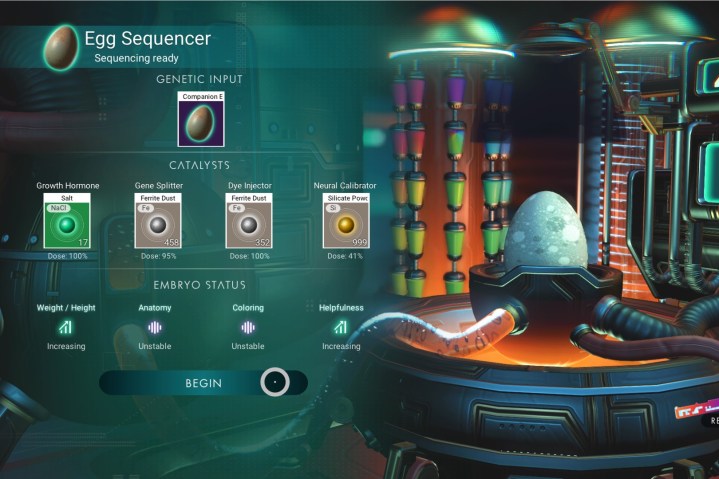No Man’s Sky has totally reinvented itself over the past few years. Originally, the game was a little bit of a disappointment. With lagging, bugs, and glitches, the game was often left on players’ shelves. However, as time went on, Hello Games found new and creative ways to not only fix some of the problems but also give us new reasons to return to the stars.
The most recent patch for the game even introduced a new way to interact with the environment. We’re now able to have alien animal companions to help us explore the universe in ways we haven’t done before. Each animal friend will lend their different skills to help you explore the galaxy and find new materials. If you’re having trouble figuring out how to manage your new, sweet alien friends, we have some tips!
Further reading:
- No Man’s Sky: 20 essential tips for starting out
- How to play a multiplayer game in No Man’s Sky
- No Man’s Sky base-building guide
- How to hatch a living ship in No Man’s Sky
Raising and training animal companions

The first step in this entire process is finding an animal friend that’s right for you. Explore the planets and universe and check out all the fauna available. Each pet will bring something different to the table. A predator, for example, will help you fight off sentinels or other hostile creatures and scout for trouble ahead of you. By contrast, the more docile creatures will help you find hidden items and harvest materials. Either way, you can also ride these little sweeties whenever you need, which is nice.
You’re able to train and domesticate just about any animal, including predators. The only pets you may struggle to get are the ones that fly. We found a planet with giant flying beetles, but these guys definitely did not want to be fed. It was devastating to learn. So keep in mind that most but not all aliens will be open to becoming a pet.
Once you’ve found the perfect pet, you’ll need to chase it down and feed it. You can feed it by holding the Square button, which was offered even before this update. After feeding the animal, you’ll notice it jumps for joy and it will give you a brand-new menu. One of the important things to note is that, at first, you’ll only be able to have three pets. In total, you’ll be able to have six, but three of the slots will need to be unlocked using Nanites. And you’ll need lots of Nanites to unlock all six slots.
By adding it as a pet, you’ll be able to summon the animal whenever you want. You can summon your pet in a way similar to how you would summon your ship or Exocraft. Press down on the D-pad, then scroll to the side until you see the paw print. This will give you a list of your pets to quickly summon and an option to go into the Pet Menu.
The Pet Menu is one of the most helpful resources in this whole process. Not only will it show every pet you have, but you’ll also see what your pets’ home planets are and what their personalities are like, and you’ll have the ability to rename them. You’ll need to navigate to this window quite a bit if you’re trying to hatch and splice eggs, but we’ll explain that further down.
If you find that you no longer want one of your pets, you have a few options to remove it as well. The first is, of course, to abandon it. Navigate your way into the Pet Menu and hover over the pet you want to remove. You should see an option to hold R3 to abandon the animal. However, there is one more way that’s perhaps a little cruel. You could just kill it. Even though these alien animals are your pets, that doesn’t make them invincible. It’s a good way to get a few resources, but it’s also sort of cruel. The choice is up to you!
Splicing for science

Once you have your new pet, you’ll notice a few changes to how you interact with it. You’ll be able to pat the animal, give it a treat (if you have creature pellets or treats in your inventory), ride the beast, customize its appearance, or induce an egg. Raising its friendship level with you will increase the quality of items the pet finds or the risks it will take to save you. Having a good relationship with your pet is important to getting quality eggs. Additionally, Customize Appearance lets you add packs onto the pet and change the packs’ color. Some creatures will help you harvest, so keeping a pack on your pet is not a bad idea.
The option you’ll really want to check out is Induce Egg. When you first get the pet, the countdown starts at 24 hours. You’ll have to wait an entire day before your pet will gestate its first offspring. This part is a little annoying, but it’s not impossible. You’re just going to have to wait for time to pass. After 24 hours, you’ll be able to harvest your first egg from your pet. But there’s a catch: The only way to induce the egg is by going to the creature’s native climate.
That’s where the Pet Menu comes in handy. It’s super easy to forget where you found a pet, especially if you traversed the galaxies to find this one particular pet. But you can see what type of atmosphere the pet came from. You don’t have to find the exact, say, Toxic planet that you found the pet on to induce the egg — a random Toxic planet will work for you just the same. It’s not a perfect system for finding the planet you need, but it’s a good jumping-off point to start searching.
After inducing the egg, you’ll have two options. If you love the pet you have now and see no way of wanting to change it, you can just wait and let this bad boy hatch. Then you’ll have another pet just like the one you hold so dearly! However, you can also change and genetically modify your egg before even meeting your pet. Much like selective breeding, using the Egg Sequencer will modify your egg and give you attributes you may want to see in your pet. To genetically alter your pet, you’ll need to do some things a little differently.
Once you have the egg of the pet you most desire, head up to the Space Anomaly. A new machine called the Egg Sequencer has been added to the Anomaly, next to the appearance modifier. You’ll need to bring your egg there to start splicing.
This is where things get a little tricky: You can add your egg in and start testing different materials (Carbon, Oxygen, etc.) to get the changes you want, but pay attention to what the materials actually do to the egg. Once you’ve added the materials, it’s a simple sit-and-wait game again. The Egg Sequencer will take 24 hours to create your newest pet addition. Be sure to have an extra space in your Pet Menu for your newest little pet baby.
Note that each item will have a different effect on the egg and the offspring, so you could unintentionally change too much about your creature. This could lead to scientific sadness, if you know what we mean. We currently haven’t gone that far with splicing just yet, but with a little creative experimentation, you can find out what types of biological horrors you can create with the Egg Sequencer.



